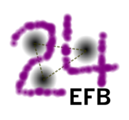Speaker
Description
The Glasgow Nuclear Physics research group has maintained a long interest in few-body physics, studying two- and three-body nucleon-nucleon interactions using real and virtual photons at the Mainz 1.6 MeV Microtron (A1, A2 collaborations) and at the Jefferson Laboratory 12 GeV accelerator (CLAS collaboration). Initial work at Mainz looked at the role of neutron-proton correlations in a range of light nuclei to investigate experimentally observed reduced nucleon occupancies compared to shell model predictions. The observed pair-momentum distributions were found to be sensitive to short-range nucleon–nucleon (SRC) interactions. Experiments with polarised photons provided a sensitive method to study SRC and indicated correlations were also present in the much weaker proton-proton pair emission channel. The role of three-body forces was studied using electron scattering measurements on 3He and by looking at three-nucleon emission reactions. More recent work at Jefferson Lab has focussed on SRC at higher energies in heavier nuclei. This work has investigated the isospin dependence of SRC and suggested a connection between SRC and the EMC effect, in which the structure function F2(xB,Q2) observed in Deep Inelastic Scattering (DIS) on nucleons bound in heavy nuclei is reduced at high xB, and high Q2, compared to the same structure function on unbound nucleons.

